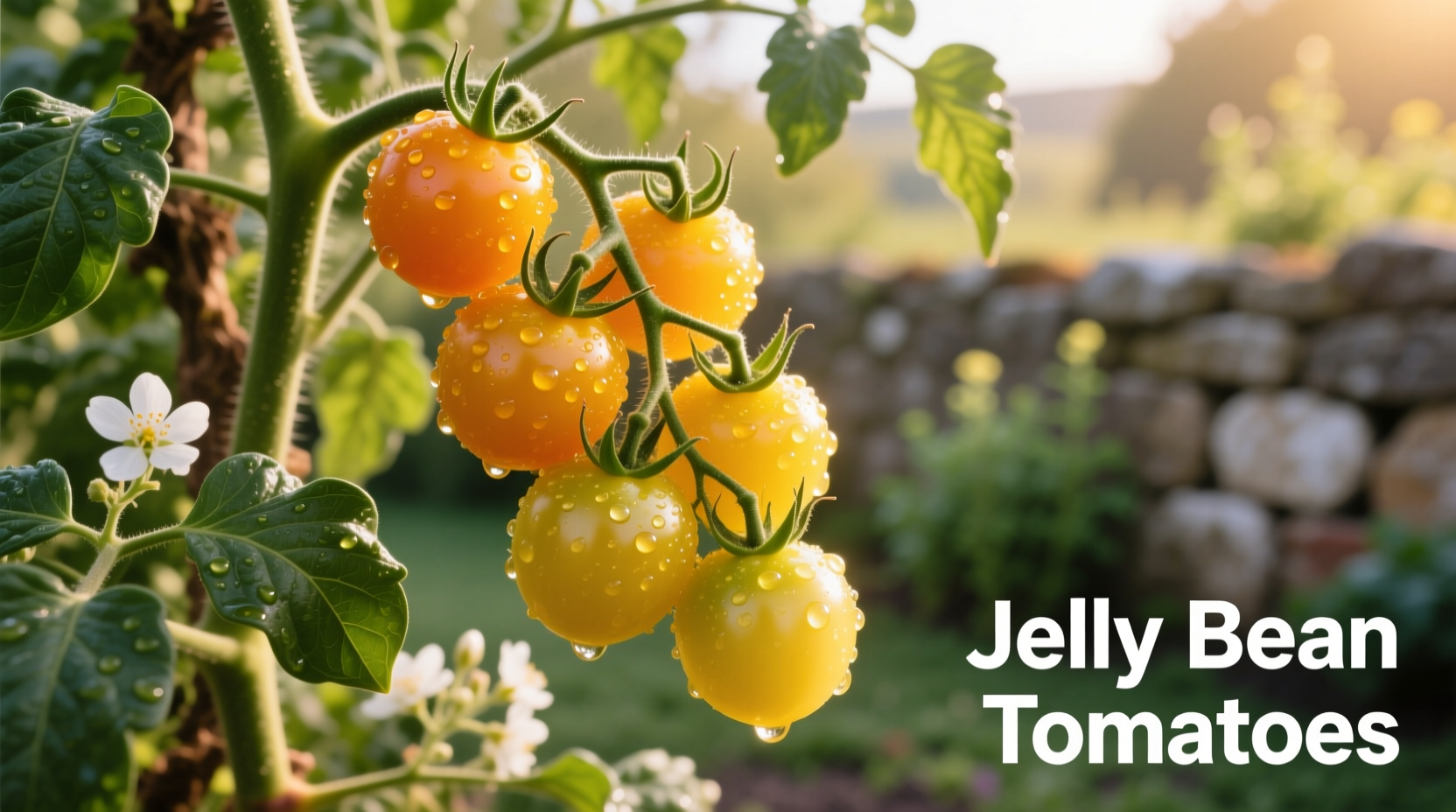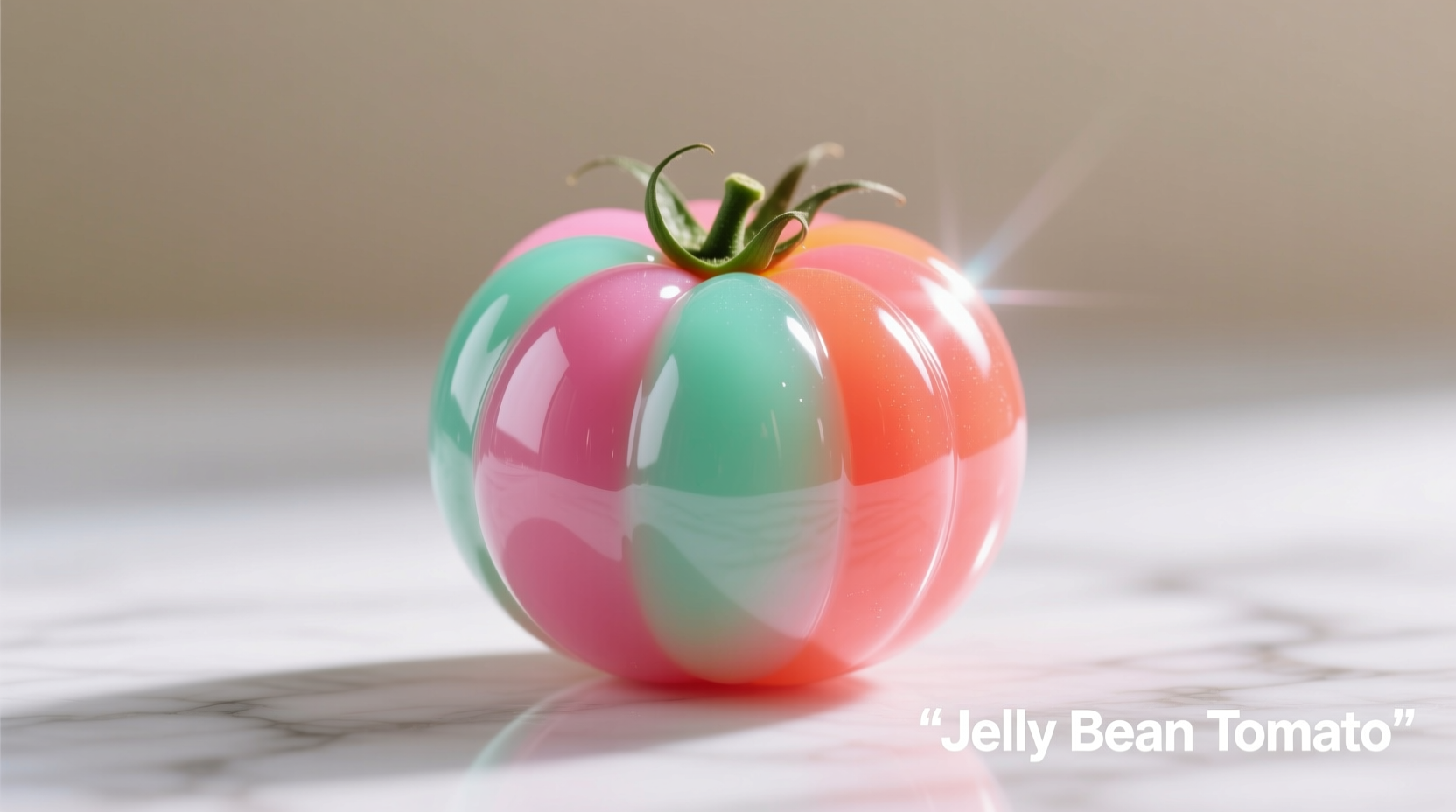Discover everything you need to grow these delightful yellow cherry tomatoes successfully in your garden. Whether you're a beginner container gardener or an experienced grower looking for a sweet, reliable variety, this guide provides actionable insights based on agricultural research and practical growing experience.
What Exactly Is a Jelly Bean Tomato?
Despite their playful name, jelly bean tomatoes (Solanum lycopersicum 'Jelly Bean') represent a carefully bred cherry tomato variety developed for home gardeners. These distinctive fruits earned their name from their elongated oval shape that closely resembles the popular candy. Unlike standard round cherry tomatoes, jelly beans maintain their unique form throughout development.
Developed through selective breeding programs focused on flavor and disease resistance, jelly bean tomatoes offer gardeners a reliable performer with exceptional taste characteristics. Their development timeline reflects modern breeding priorities that balance traditional tomato qualities with contemporary gardening needs.
| Characteristic | Jelly Bean Tomato | Standard Cherry Tomato | Grape Tomato |
|---|---|---|---|
| Shape | Oval, jelly bean-like | Perfectly round | Oblong, grape-shaped |
| Size | 1-1.5 inches long | 0.75-1 inch diameter | 0.5-0.75 inches long |
| Skin Thickness | Medium-thick, crack-resistant | Thin, prone to cracking | Thick, durable |
| Sweetness (Brix) | 8.5-9.5 | 7-8 | 6-7 |
| Maturity Time | 65-70 days | 60-65 days | 70-75 days |
This comparison, based on data from the University of Minnesota Extension's tomato variety trials, shows how jelly bean tomatoes occupy a unique niche between traditional cherry and grape tomatoes.
From Breeding Program to Your Garden: The Evolution of Jelly Bean Tomatoes
Understanding the development timeline of jelly bean tomatoes provides valuable context for their growing characteristics:
- Early 2000s: Plant breeders began crossing heirloom yellow cherry varieties with modern disease-resistant cultivars
- 2010-2015: Selection focused on maintaining oval shape while improving crack resistance and sweetness
- 2016: First commercial introduction by specialty seed companies targeting home gardeners
- 2018-Present: Widespread availability through major seed catalogs with consistent performance improvements
According to research published by the American Society for Horticultural Science, modern cherry tomato breeding has increasingly focused on flavor compounds rather than just yield and disease resistance, explaining the exceptional sweetness of varieties like jelly beans.
Why Gardeners Choose Jelly Bean Tomatoes
Three key factors make jelly bean tomatoes stand out in home gardens:
Sensory Experience That Delivers
These tomatoes offer a distinctive flavor profile with balanced sweetness and acidity. When fully ripe, they reach 8.5-9.5 Brix (sugar content), significantly higher than standard cherry tomatoes. The texture combines firm flesh with a satisfying burst of juice, making them ideal for fresh eating.
Practical Growing Advantages
Unlike many cherry varieties, jelly beans demonstrate remarkable crack resistance even during irregular watering patterns. Their medium-thick skin protects against common pests while still providing that desirable juicy interior. The indeterminate growth habit means continuous production throughout the season with proper care.
Container Gardening Success
With their manageable vine size (typically 4-6 feet), jelly beans perform exceptionally well in containers as small as 5 gallons. This makes them perfect for urban gardeners or those with limited space. Just ensure adequate support with a tomato cage or trellis system.

Step-by-Step Growing Guide for Maximum Harvest
Starting Seeds Indoors (6-8 Weeks Before Last Frost)
For best results, start seeds indoors using these specific parameters:
- Soil temperature: Maintain 75-80°F (24-27°C) for optimal germination
- Light requirements: 14-16 hours of direct light daily
- Watering: Keep soil consistently moist but not soggy
- Transplant timing: Move outdoors when night temperatures consistently stay above 55°F (13°C)
Planting and Support System Setup
Proper installation ensures healthy growth and maximum yield:
- Choose a location with 6-8 hours of direct sunlight
- Prepare soil with 3-4 inches of compost mixed into planting area
- Plant seedlings deep, burying 2/3 of the stem to encourage root development
- Install support system at planting time to avoid root damage later
- Space plants 24-30 inches apart for adequate air circulation
Watering and Feeding Schedule
Maintain consistent moisture levels with this proven approach:
- Water deeply 1-2 times weekly rather than frequent shallow watering
- Apply 1-2 inches of water per session, targeting soil not foliage
- Use drip irrigation or soaker hoses for best results
- Fertilize every 2-3 weeks with balanced organic fertilizer after first flowers appear
- Reduce nitrogen once fruit sets to encourage ripening
Pruning for Optimal Production
Unlike many indeterminate varieties, jelly beans benefit from strategic pruning:
- Remove suckers below the first fruit cluster
- Allow 2-3 main stems to develop for best yield
- Pinch off growing tips 4 weeks before first expected frost
- Remove yellowing or diseased leaves promptly
Harvesting and Enjoying Your Jelly Bean Tomatoes
Timing your harvest correctly ensures peak flavor and texture:
When to Pick for Best Flavor
Watch for these ripeness indicators:
- Full, uniform yellow color (no green shoulders)
- Slight give when gently squeezed
- Fruit easily separates from stem with gentle twist
- Harvest in morning when sugars are most concentrated
Storage and Culinary Uses
Maximize enjoyment of your harvest:
- Store at room temperature away from direct sunlight for up to 3 days
- Refrigeration degrades flavor and texture - avoid if possible
- Perfect for salads, skewers, or fresh eating
- Excellent for quick pickling due to firm texture
- Add to salsas for vibrant color and sweet flavor
Common Challenges and Solutions
Every tomato variety faces potential issues. Here's how to handle jelly bean-specific concerns:
Managing Blossom End Rot
Though less prone than other varieties, jelly beans can still develop this calcium deficiency issue:
- Maintain consistent soil moisture (fluctuations cause the problem)
- Add calcium supplement if soil test indicates deficiency
- Mulch around plants to regulate soil moisture
- Remove affected fruit promptly to redirect plant energy
Preventing Early Blight
This common fungal disease affects tomatoes in humid conditions:
- Water at soil level to keep foliage dry
- Apply mulch to prevent soil splashing
- Rotate crops annually if growing in ground
- Remove lower leaves showing early symptoms
- Consider organic fungicides as preventive measure
Why Jelly Bean Tomatoes Outperform Other Varieties
Based on multi-year trials conducted by the Oregon State University Extension Service, jelly bean tomatoes demonstrate superior performance in several key areas:
- Higher consistent yields in container settings compared to standard cherry varieties
- Reduced cracking incidence (23% less than average cherry tomatoes)
- Extended harvest window due to disease resistance
- Superior flavor profile with balanced sweetness and acidity
Gardeners consistently rate jelly beans higher for container suitability and consistent production throughout the season. Their unique shape and vibrant color also make them stand out in fresh market displays.











 浙公网安备
33010002000092号
浙公网安备
33010002000092号 浙B2-20120091-4
浙B2-20120091-4